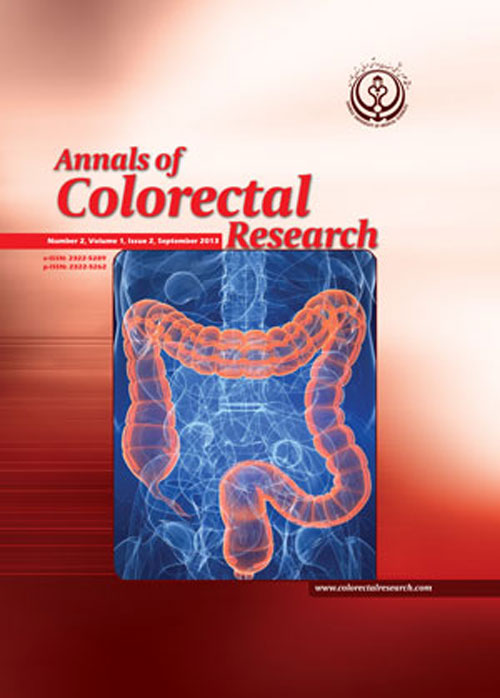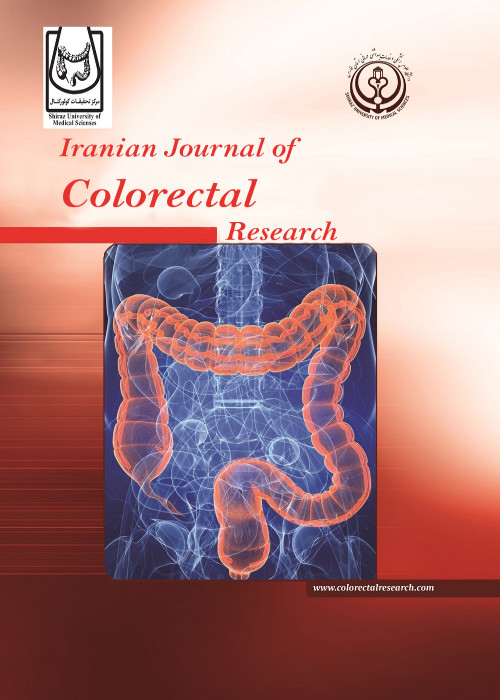فهرست مطالب

Iranian Journal of Colorectal Research
Volume:4 Issue: 2, Jun 2016
- تاریخ انتشار: 1395/03/30
- تعداد عناوین: 5
-
-
Page 2Context: The mobile right colon is a developmental aberration. During the development and rotation of the gut, the cecum and ascending colon are the last to take their final position and fuse with the posterior abdominal wall..
Evidence Acquisition: Though a mobile right colon may be present in 20% - 30% of the population but causes symptoms in very few. The patients present intermittent colicky right lower quadrant abdominal pain with associated abdominal distention and symptomatic relief after passing flatus or having a bowel movement..ResultsNon fixation along with heavy load of the right colon drags the cecum and ascending colon down and leads to stasis, obstruction or volvulus. The diagnosis of this entity is very difficult as radiological studies are not conclusive..ConclusionsThe mobile colon syndrome should be considered in the differential diagnosis of right lower quadrant pain from obscure causes. A proper detailed history is a must to consider this as differential diagnosis. Laparoscopy offers diagnostic and therapeutic treatment. Colopexy provides dramatic relief in carefully selected patients..Keywords: Mobile Right Colon, Stasis, Obstruction, Colopexy -
Page 3BackgroundColorectal cancers (CRCs) often occur in octogenarians. However, data on treatment and survival are sparse..ObjectivesOctogenarians were studied in order to gain data on treatment, outcomes, and survival related to CRC..
Patients andMethodsAll consecutive octogenarians with CRC in the period of 2002 - 2008 were included. An extensive review of hospital records was carried out. Patients were divided into two groups, as follows: group 1 included patients who were alive after five years of follow-up, while group 2 comprised patients who died within 5 years of their diagnosis. Cause of death was determined and classified as related to cancer, non-related, or because of treatment..ResultsOne hundred and eleven octogenarians were diagnosed with CRC (82 colon cancers and 29 rectal cancers). Patients in group 2 had a significantly higher disease stage compared with group 1 (PConclusionsThe co-morbidity score is important in survival after surgery. Forty-four percent of octogenarians with CRC died because of non-tumor-related disease or illness. Fit elderly people can benefit from standard therapy for CRC..Keywords: Octogenarians, Colorectal Cancer, Epidemiology, Survival, Recurrence -
Comparison of Preoperative Ultrasonography and Pathology Results of Patients Undergoing AppendectomyPage 4BackgroundIt is still difficult to make the diagnosis of acute appendicitis in children with only clinical examination..ObjectivesThe present study, retrospectively reviewing the data of the patients that underwent appendectomy, aimed at emphasizing the diagnostic value of ultrasonography findings by comparing them with pathological diagnosis..
Patients andMethodsThis retrospective study included patients aged under 18, who were operated on for appendicitis between 1 January 2015 and 31 December 2015. The relationship between the pathology results of these patients and the results of preoperative ultrasonography performed for the diagnosis of acute appendicitis was investigated..ResultsThe study included 100 patients, 42 were female and 58 were male, on whom ultrasonography was performed and whose mean age was 11.3 ± 3.7 years. While there were 28 (28%) patients who did not receive a definitive diagnosis of appendicitis pathologically, there were 43 (43%) patients in whom there were no ultrasonography findings supporting appendicitis. While appendicitis diagnosis was made pathologically in 72 patients (72%), suggestive findings of appendicitis, such as compression and double wall thickness of the appendix (over 6 mm), were detected in 57 patients (57%). In addition, 42% periappendiceal fluid collection, 25% periappendiceal fat inflammation, and 14% appendicolith were detected by ultrasonography. While 47 (65.3%) of the 72 patients with pathologically confirmed appendicitis received appendicitis diagnosis by ultrasonography, 25 (34.7%) did not (Pearson square test P = 0.007). The sensitivity and specificity of ultrasonography in the diagnosis of appendicitis were 66.6% (48/72) and 64.28% (18/28), respectively..ConclusionsAccording to the results of the current study, ultrasonography, in the diagnosis of appendicitis, should only be used for the support of clinical diagnosis or for differential diagnosis..Keywords: Ultrasonography, Appendicitis, Diagnosis, Children -
Page 5BackgroundUlcerative colitis (UC) is a multi-factorial disease with unknown etiology and has many clinical manifestations..ObjectivesThe current study aimed to evaluate the effects of sesame oil (SO) and grapeseed oil (GSO) on acetic acid-induced UC in rats..Materials And MethodsEighty male rats were divided into eight groups as health control (HC1), received normal saline; HC2, received SO; HC3, received GSO; negative control (NC), UC and normal saline; positive control (PC), UC and mesalamine; SO, UC and SO; GSO, UC and GSO, and SO GSO. The daily weight changes, serum levels of oxidative stress markers and lipid profile plus colon macroscopic and microscopic histological changes were measured at the end of the seventh day..ResultsSignificant differences were detected between HC1 and PC on the 3rd (P = 0.002), 4th (0.013) and 6th days (0.014) and between HC1 and NC on the 4th day (0.027) in weight of rats. Use of GSO alone or in combination with SO decreased the extent of the changes both in macroscopic and microscopic indices and also at the inflammation level. The most significant decrease in the MDA level and the most obvious increase in the TAC belonged to the GSO group in comparison to the NC group. The lowest cholesterol (51.43 ± 5.62 mg/dL) and HDL levels (29.29 ± 6.24 mg/dL) were detected in response to SO consumption in comparison to NC group (P = 0.030 and P = 0.257, respectively)..ConclusionsGSO in combination with SO may be considered as the treatment of choice for UC based on antioxidant and histopathological evaluations..Keywords: Grapeseed Oil, Sesame Oil, Ulcerative Colitis, Oxidative Stress, Histopathology


